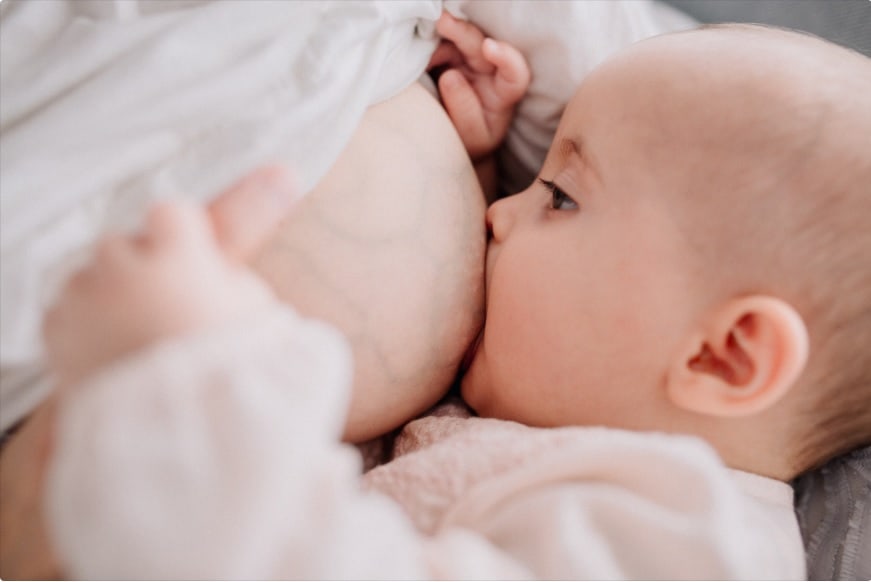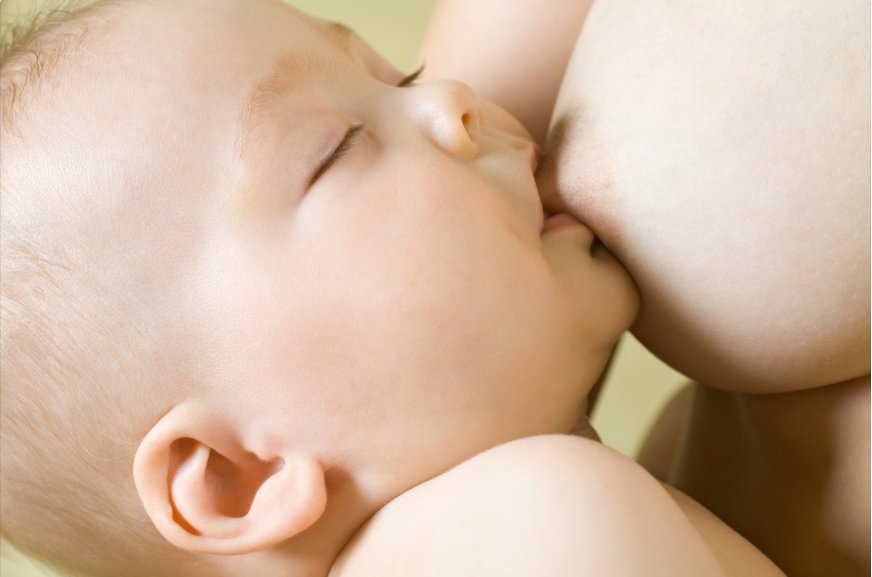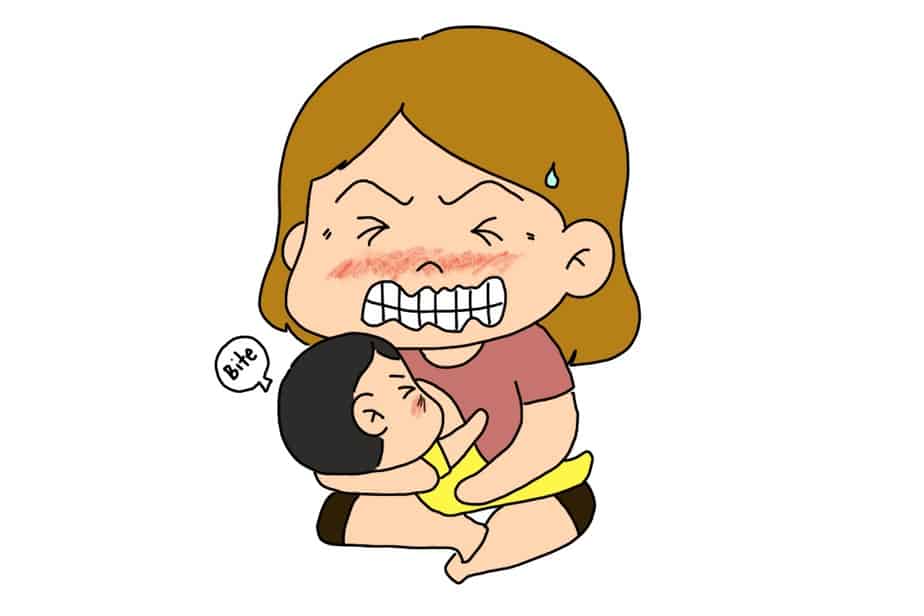Breastfeeding is a lot of work, it takes up a lot of my time. I even have to pump while not breastfeeding. Then one day, my boy began to bite the nipple! It was so painful my eyes teared, and the sudden unexpected bite makes me fearful when breastfeeding him. Teething time has come, and breastfeeding has just gotten harder, so I had to learn and find ways to continue breastfeeding. Hopefully, my learning can help you.
So how to breastfeed a teething baby? Make sure your baby is latched on correctly and most of the areola should be in his mouth. As he feeds in the correct position, his tongue is extended over his lower gums and he cannot bite. A correct latch will stop your baby from biting the nipple.
Let’s look at how to help your baby latch on correctly, and what are the other ways to make our baby stop biting while breastfeeding.
Make Sure Your Baby Is Latched On Correctly
Proper positioning was the most important for me. When I and my baby is comfortable, it’s easier to latch correctly and the feeding session usually goes quite well. I make sure my back is well supported and relaxed.
The tip of the nipple should be at the top inside his mouth, the part slightly behind where it becomes soft. Try putting your tongue at the back of your mouth, check at which point it becomes soft at the top, that’s roughly how far your nipple should go.
Our baby’s mouth should cover most of our areola, then the latch will be painless with excellent milk flow. Here’s a picture of a correct latch, the baby’s mouth is wide open and covers most of the areola.

If your baby’s lips are clamping down on your nipple, the latch is wrong, try again. This type of latch will not only make your nipple sore, but milk flow will be very low. Your baby will end up putting a lot of effort and get very little milk. Your baby may start pulling at the nipple and cause more pain. Here’s a picture of a wrong latch, notice that the baby’s lips are on the nipple instead of the areola.

I found this video to be extremely helpful, the lady thought me how to latch my baby correctly with visuals and other tips. Continue reading after the video as I will talk more about other relevant tips.
When my baby bites, I will put a finger into his mouth and pull out the nipple, and tell him firmly, no. I remind myself not to get angry, he doesn’t understand and doesn’t deserve it, I just use a very firm tone and wait for a few seconds before giving him the breast again. After repeating this for a few times he stopped biting. Sometimes, he will test the ground and when I sense that he’s about to bite, I will warn him using that firm tone.
4 ways to soothe their gums to make breastfeeding easier
Your baby can have sore gums when he is teething and he may feel irritated enough that he loses his appetite and refuse to feed. Here are some ways to soothe his gums, it can bring back his appetite and make him less cranky, and this leads to a better breastfeeding experience.
1. Soothing with ice popsicles
This is our favorite method. We make ice popsicles and stuff them inside silicone pouches, other times we stuff finely cut chilled fruits into it. Our boy loves it! He will keep chewing on it until all the ice melts or the juice are all dry, it soothes his gum sores and makes feeding easier. This is the pouch I’m talking about from Amazon.
We tried this method when he was 6 months old because prior to that we want our baby to be purely breastfed. We chose apples and grapes, he never got bored of it. Some parents use frozen fruit and include bananas, which are all fine methods.
2. Massaging the gums
Wrap a clean cloth around a clean finger to massage your baby’s gums to ease his gum pains. When his gums are soothed it reduces the chances of biting.
When his teeth are out though, he may bite your finger and that can be very painful, especially if he bites the flesh around the cuticle, ouch! I find it better when I use a finger teether for protection. You can get 1 from Amazon here. It’s a good idea to get 2, it’s very useful for brushing your baby’s gums and teeth.
3. Use a chilled teether ring
Let your baby bite on a chilled teether ring, it can numb the pain and reduce biting. Chill it with the refrigerator, do not put it in the freezer as it can become too cold, too hard or make the edges sharp. Here’s a good one with good reviews on Amazon. Alternatively, you can chill a small cloth, soak it in cold water and let your baby chew on it. Just make sure you monitor your baby so the cloth doesn’t become a choking hazard.
4. Use a pain reliever
I’m not a fan of this, I don’t want my boy on medication unnecessarily. But my boy’s pediatrician gave us some teething gel to apply because his gums were swelling and became red during teething. She advised us to put the gel in the fridge as our babies will like it more when it’s chilled. Simply press the gel onto your fingers in a moderate amount and start rubbing it on the gums. Check with your pediatrician and let her prescribe the necessary meds. I highly recommend that you do not find pain relievers yourself as it can contain substances fatal to your baby.
Biting While Breastfeeding And How To Avoid It
You’ve now understood that if a baby latches on correctly, he cannot bite the nipple. But sometimes, he can still bite! Let’s look at some of the reasons.
1. Biting near the end of a feeding session
If you notice your baby bites during the end of the feeding session, he is most probably already full. Breastfeeding usually takes 30-40 minutes so it’s difficult to be fully attentive throughout the whole session.
When he is full, his latch begins to loosen and before you notice it, he is no longer in the correct latch with teeth around your nipple. When your baby stops sucking, it’s a good idea to first unlatch him and check if he wants more before latching back on again. Try to be attentive to the sucking and eventually you’ll notice it when he stops.
2. Biting due to lack of attention
I’ve heard other moms saying that biting happens less when they are paying attention to their baby while breastfeeding by locking eyes with their baby and talking to him. I haven’t tried this and I admit I can’t do this all the time, I breastfeed him six to ten times a day and it’s difficult to pay attention every time, but it works for them so I’m sharing their experience with you.
3. Biting due to lack of milk
If your baby is pulling back and forth while feeding, it can mean that there’s a dip in milk supply and your baby wants more milk. Sometimes the breast has run out of milk and its time to switch breast.
I take milk boosters to boost my milk supply when milk production drops, and it has been very helpful. If you want to check if there’s milk, pinch your areola with 2 fingers and milk will shoot out. If no milk comes out then supply is probably low or out.
What can you do if your baby bites and doesn’t let go?
This doesn’t happen to most babies, but if your little one does this, put a finger into his mouth, then between his gums before you pull your breast away. You can cause more injuries to yourself if you immediately pull off without first loosening the bite.
When they bite, there’s nothing babylike or weak about it, they bite hard! Another way is to make him instinctively open his mouth by closing his nose, he will open his mouth because he needs to breathe.

